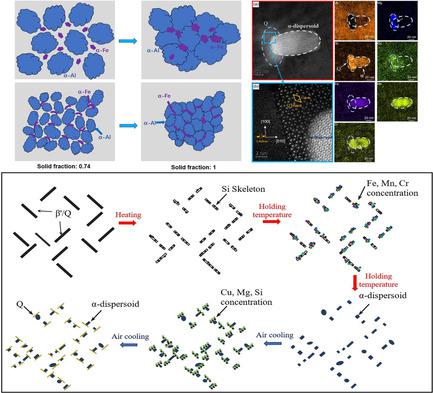当前位置:
X-MOL 学术
›
Adv. Eng. Mater.
›
论文详情
Our official English website, www.x-mol.net, welcomes your
feedback! (Note: you will need to create a separate account there.)
Microstructural Refinement and α‐Dispersoid Evolution in Direct‐Chill Cast Al–Mg–Si–Fe Alloy
Advanced Engineering Materials ( IF 3.4 ) Pub Date : 2020-08-10 , DOI: 10.1002/adem.202000517 Dongtao Wang 1, 2 , Haitao Zhang 1, 3 , Hiromi Nagaumi 1, 2 , Xueke Li 3 , Jianzhong Cui 3
Advanced Engineering Materials ( IF 3.4 ) Pub Date : 2020-08-10 , DOI: 10.1002/adem.202000517 Dongtao Wang 1, 2 , Haitao Zhang 1, 3 , Hiromi Nagaumi 1, 2 , Xueke Li 3 , Jianzhong Cui 3
Affiliation

|
High Fe levels, coarse grains, microstructural inhomogeneities, and coarse dispersoids for recrystallization suppression remain problems for industrial application of Al–Mg–Si (6xxx) alloys. Herein, Al–0.81%Mg–0.81%Si–0.7%Fe alloy billets are fabricated by direct chill (DC) casting at different casting speeds. The results indicate that high‐speed (300 mm min−1) DC casting can provide fine grains, refined Fe‐containing phases, relatively high solid–solute content, and improved distribution of Mn and Cr. After homogenization at 500 °C for 6 h, the α‐AlFeMnCrSi dispersoids in the high‐speed cast billet decrease in size and increase in number density, compared with the conventional cast billet (100 mm min−1). The low homogenization temperature (440 °C) also contributes to the size reduction and increases the number density of dispersoids. Air cooling after homogenization (holding temperature ≥500 °C) results in Q‐AlCuMgSi precipitation, which depends on the precipitated substrate of the α‐AlFeMnCrSi dispersoids. Moreover, the precipitation processes of α‐dispersoids and Q phases are discussed according to transmission electron microscopy (TEM) and high‐angle annular dark‐field scanning transmission election microscope (HAADF‐STEM) results. These results mean that high‐speed DC casting can effectively improve the as‐cast microstructure by increasing the cooling rate, and the as‐cast microstructural evolution promotes the precipitation of fine and dense α‐dispersoids from the α‐Al matrix.
中文翻译:

直冷铸造Al-Mg-Si-Fe合金的组织细化和α-弥散相的演变
高铁含量,粗大晶粒,微观结构不均匀性和抑制再结晶的粗大弥散体仍然是Al-Mg-Si(6xxx)合金工业应用的问题。在这里,Al–0.81%Mg–0.81%Si–0.7%Fe合金坯是通过直接冷铸(DC)以不同的铸造速度铸造而成的。结果表明,高速(300 mm min -1)直流铸造可以提供细晶粒,细化的含铁相,相对较高的固溶含量以及改善的Mn和Cr分布。在500°C下均化6 h后,与常规铸坯(100 mm min -1)相比,高速铸坯中的α-AlFeMnCrSi弥散体尺寸减小,数量密度增加。)。较低的均质温度(440°C)也有助于减小尺寸并增加分散体的数量密度。均质化后的空冷(保持温度≥500°C)导致Q-AlCuMgSi沉淀,这取决于α-AlFeMnCrSi分散质的沉淀基质。此外,根据透射电子显微镜(TEM)和高角度环形暗场扫描透射电子显微镜(HAADF-STEM)的结果,讨论了α-弥散相和Q相的沉淀过程。这些结果表明,高速直流铸造可以通过提高冷却速率来有效地改善铸态组织,而铸态组织的演变促进了细小且致密的α-弥散体从α-Al基体中析出。
更新日期:2020-08-10
中文翻译:

直冷铸造Al-Mg-Si-Fe合金的组织细化和α-弥散相的演变
高铁含量,粗大晶粒,微观结构不均匀性和抑制再结晶的粗大弥散体仍然是Al-Mg-Si(6xxx)合金工业应用的问题。在这里,Al–0.81%Mg–0.81%Si–0.7%Fe合金坯是通过直接冷铸(DC)以不同的铸造速度铸造而成的。结果表明,高速(300 mm min -1)直流铸造可以提供细晶粒,细化的含铁相,相对较高的固溶含量以及改善的Mn和Cr分布。在500°C下均化6 h后,与常规铸坯(100 mm min -1)相比,高速铸坯中的α-AlFeMnCrSi弥散体尺寸减小,数量密度增加。)。较低的均质温度(440°C)也有助于减小尺寸并增加分散体的数量密度。均质化后的空冷(保持温度≥500°C)导致Q-AlCuMgSi沉淀,这取决于α-AlFeMnCrSi分散质的沉淀基质。此外,根据透射电子显微镜(TEM)和高角度环形暗场扫描透射电子显微镜(HAADF-STEM)的结果,讨论了α-弥散相和Q相的沉淀过程。这些结果表明,高速直流铸造可以通过提高冷却速率来有效地改善铸态组织,而铸态组织的演变促进了细小且致密的α-弥散体从α-Al基体中析出。











































 京公网安备 11010802027423号
京公网安备 11010802027423号